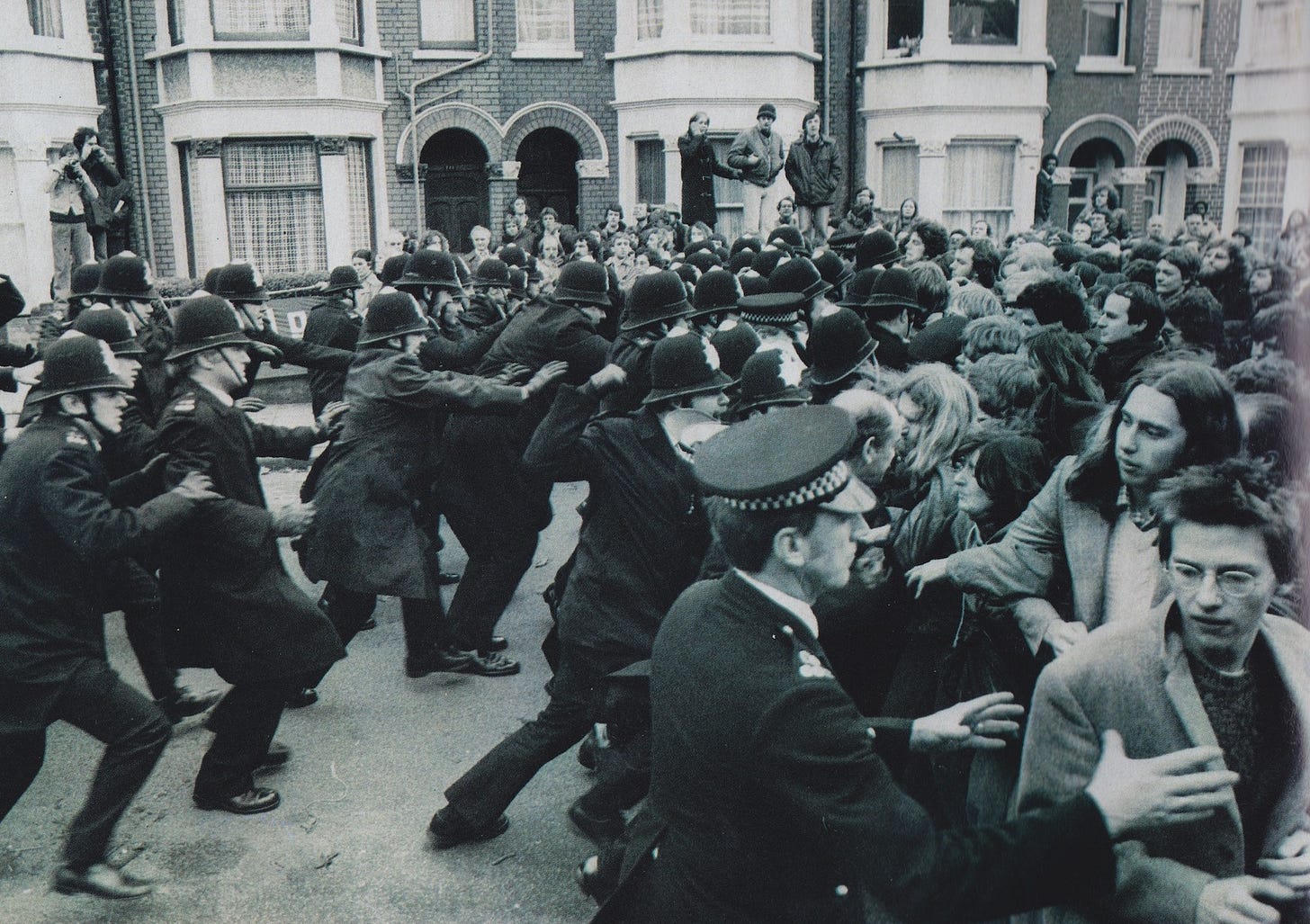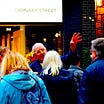I am really delighted that I started this series. I have immensely enjoyed collaborating with people and every picture really does tell a story. It’s a privilege to be able to share this incredible first hand account of power, division, unity and solidarity by Mike.

What is the picture of?
At first glance, it’s the 1970s. You can tell by the lapels, the hairstyles, the police helmets, and the John Lennon specs. The row of terraced houses—stuccoed bays, arched doorways, net curtains—places it firmly in north London suburbia. A historian of architecture could probably tell you the exact street.
We see a line of police officers charging forward with arms braced and fists raised. Their bodies lean into the crowd, a blur of helmets and grim faces. The people they're charging into—mostly young, from what we can see—have no space to escape. Behind them, the pavement is packed with older faces, watching.
But despite the aggression, there’s little fear in the expressions of those facing the charge. Look closely. There’s defiance. A sense of collective determination. Against the garden wall to the left, a trade union banner leans—probably NALGO. Two photographers stand above it, camera shutters snapping, recording the scene.
This is not a candid image. It was chosen to tell a story. On the front page of The Times, 23 June 1977, this photograph accompanied a headline about a riot, about police being forced to restore law and order in the face of a rampaging crowd on the streets of London outside a photography processing laboratory in Dollis Hill.
But that’s not what was happening. I know—because I was there.
Why did you choose it?
Some moments change your life. They shape the way you see the world and remind you of who you are. This was one of mine.
You see the man in the glasses at the front? That’s Dave, my friend and housemate. He drove the two of us to the Grunwick picket line that morning in his battered old VW Beetle. I was standing just to his left when this photograph was taken.
The street was packed—some reports say up to 20,000 people. Yes, there were students like us. But most were trade unionists: miners from Wales and Yorkshire, print and postal workers, car workers from Luton and Dagenham, local government employees, MPs, Labour Party members. The picket was supported by the TUC and organized in solidarity with Jayaben Desai and her fellow strikers—the women she called her lions.
Grunwick was a photo-processing plant. Its workforce was mainly South Asian women—many from Indian and East African backgrounds. They were paid poverty wages, denied toilet breaks, forced into overtime. When they joined a union, they were sacked. Desai, small in stature but fierce in spirit, told her manager on her dismissal:
"What you are running here is not a factory, it is a zoo. In a zoo, there are many types of animals. Some are monkeys who dance on your fingertips, others are lions who can bite your head off. We are those lions, Mr Manager."
It was energising and inspiring to stand in that crowd. There had been some speeches from Jayabean Desai and others. We were far from the factory gates, and as the time passed, Dave and I were thinking of heading home.
Then the SPG arrived.
The Special Patrol Group was the Met’s riot squad—a unit known for its brutality. Two years later, members of the SPG would be implicated in the death of Blair Peach at an Anti Nazi League demonstration in Southall. A secret internal inquiry, released thirty years later, confirmed what many already knew: he was killed by an SPG officer, probably using a lead-weighted cosh. When investigators searched SPG lockers, they found knives, two crowbars, a whip, a 3ft wooden stave and a lead-weighted leather stick. It wasn’t for nothing that in The Young Ones, Vyvyan's vicious pet hamster was named Special Patrol Group.
There had been no riot. No aggression. Just thousands of people standing together in solidarity. Then suddenly, without warning, it became terrifying. Officers began lashing out - punching faces, dragging people by their hair, pulling them to the ground, all while shouting and screaming at us.
But look at the photograph again.
Look at our faces. Look hard.
Yes, there’s fear. But there’s something else—something stronger. Determination. A refusal to be cowed. The young man standing to Dave’s left, just out of the shot, knew we were right to be there. And the old man typing these words knows it still. Still. Because that moment changed Britain. And it changed us.
How does it make you feel? What is the significance?
Proud, disappointed, enlightened, inspired and optimistic.
I feel proud, because we showed up. We got up early, crossed the city still half-asleep, and stood with thousands of others in a shared act of courage and defiance. We stood with the lions.
I feel disappointed, because the strike was ultimately lost. Lord Scarman’s inquiry recommended the strikers be reinstated and the union recognised. Grunwick ignored it. The unions backed down, then dropped the campaign. Jayaben Desai went on hunger strike outside TUC headquarters, fighting a labour movement that was still dominated by white men.
I feel enlightened, because that day stripped away any illusions I had about how power operates. There was no riot, no violence—until the SPG turned up. And then the press told a story that never happened: a mob threatening public order, not thousands standing peacefully in solidarity. I learned how easily resistance is misnamed, how brutality is dressed in the language of law.
I feel inspired—still—by Jayaben Desai and the women who stood beside her. What they began at Grunwick was part of a greater movement. Alongside the London Matchgirls in 1888 and the Dagenham Ford sewing machinists in 1968, they point to a truth we too easily forget - that it is marginalised workers who lead the way in making the most powerful challenges to injustice. Poor East End women facing lethal factory conditions. Female factory workers facing sex-based pay discrimination. Migrant women facing racism and sexism. These were the ones who shifted the ground beneath our feet. Their actions led to the new unionism of the late nineteenth century, the Equal Pay Act, and anti-racist campaigning and mobilising. All of these have benefitted every one of us over the years.
I feel optimistic, because Grunwick proved that even the most marginalised voices can roar. Like lions. Theirs was a voice that could be heard, inspiring a national movement and instilling confidence in their own communities.
We have many more challenges ahead in this fractured and dangerous age we now live in. We’ll not meet those challenges by relying on world views from the 1970s, or the political strategies from those times. But let us not forget those fundamental principles that have served us well.
I never met Jayaben Desai. She was a stranger to me. But that’s the joy and value of solidarity on an island of strangers. We hear each other’s voices. We support each other. We are inspired by each other. That’s the most significant thing I learned that day. We hold each other up. And we don’t let go.







Really incredible story Mike. The energy you have telling it all these years later is testament to that moment and its power to change an outlook. Thank you so much for sharing it with me and teaching me more about Grunwick and the people involved.
Brilliantly said, Mike, for were we not all strangers to each other at first? And when those ‘small’ women stood tall it took those ‘big, brave, men in riot gear’ to cow them. But, of course, they weren’t cowed then and were not cowed today…I hope!
And thank you, Margaret, for bringing This great window on art, history, whatevs…ha-ha! Fabulous series!